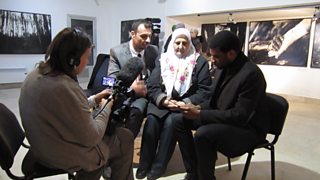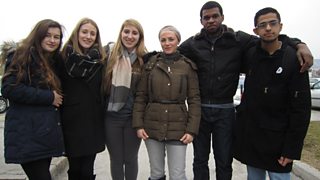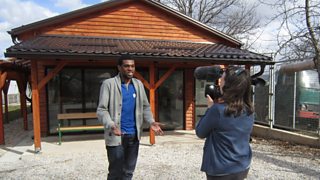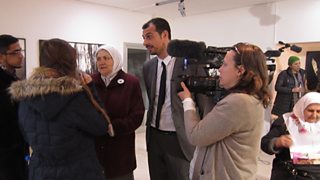
In the documentary 'A Deadly Warning: Srebrenica Revisited' journalist and British Muslim Myriam François-Cerrah travels to Bosnia, to mark the 20th anniversary of the worst atrocity in Europe since World War II. In a frequently emotional trip, she visits the site of the genocide at Srebrenica, with a group of young people all born in the year of the massacre. Here producer/director Gillian Bancroft talks about the challenges of making a film about a genocide that isn’t well remembered.
In the early 1990s I travelled to the former Yugoslavia with the British Red Cross to make a short film about refugees. They were fleeing the fighting that was tearing apart this popular holiday destination and which eventually led to independence for states like Bosnia. It’s a trip I’ll never forget but I’m ashamed to say that over the years my memory of the wider conflict had faded. I’m not alone. Ask people what they remember about Srebrenica in 1995 and few may have an answer. We needed to find a way to tell the story of a genocide that many had forgotten and convey the importance of events understood by very few.
On the 11th July 1995, General Ratko Mladić led the Bosnian Serb Army into the spa town of Srebrenica, despite its designation as a UN safe area. In the days that followed, around eight thousand Bosnian Muslim men and teenage boys were systematically massacred and buried in mass graves. Women, children and elderly were forcibly deported. Many suffered terrible abuse.
Today a British charity - - takes small groups to Bosnia to learn the lessons of this genocide. Chatting to the organisers I discovered that they sometimes take young people who know nothing about Srebrenica. Our viewers could discover the story afresh with one of these groups and reflect with them on whether it has any relevance for us here in Britain today. The film would stand or fall on the strength of their three-day visit to Bosnia.

Presenter Myriam François-Cerrah with the group she accompanied to Srebrenica
As soon as I spoke to the young people, some of my natural anxieties eased. The diverse group included Julie, the daughter of Colonel Bob Stewart who was United Nations Commander of the British forces in Bosnia in the early nineties; and medical student Abdul, who said he was astonished that he didn’t hear about the story in school and wondered why “…when Muslim people die you don’t learn about it as much”. Journalist and British Muslim Myriam François-Cerrah would go with them as our presenter. She understood that for a lot of British Muslims Srebrenica is still a very raw issue. This is a genocide that struck Europe’s oldest Muslim community and Europe failed to stop it.
The journey that followed was incredible. We visited the old battery factory just north of Srebrenica where UN peacekeepers were stationed in the 1990s. It’s now a Memorial Centre where we met a survivor of the so-called ‘Column’ of men and boys who had attempted to escape the advancing Bosnian Serb Army by walking to a region under Bosnian Muslim control. But it became a death march. I knew that a key moment for the group would be when they were shown a film detailing the three days that followed the fall of Srebrenica.

Gillian filming for the documentary A Deadly Warning: Srebrenica Revisited
The Bosnian Serb Army filmed its own actions - including the execution of many unarmed men and boys - and some of this footage is used in the film. My job at this point was to record the reactions of the young people. I didn’t actually watch the film myself. Even so the experience left its mark.
The atmosphere in the room was palpable; focusing on the expressions of the young people watching I found myself feeling physically sick. One of young group, Abdul, had to leave. He said the similar ages of the victims left him thinking about himself - ‘ you and your friend and your brother. You’re all together in a van together and you know you are about to die.’ Our presenter Myriam commented that the images are likely to stay in the mind and ‘if something positive can come from learning about that you’ve got to hope it was worth it.’

Gillian filming with the 'Mothers of Srebrenica'
From there the young people went straight to meet the ‘’. These women each lost members of their family, husbands and sons, in the massacre. The rain never stopped falling as the group walked arm in arm with the mothers around the memorial cemetery – row upon row of white markers, one for each of the thousands who died.
Myriam and the young people went on to confront the current Bosnian Serb President of Srebrenica’s Municipal Assembly, who refuses to accept that what happened here in 1995 should be termed a genocide. Finally we travelled to the mortuary where on-going forensic work is still identifying the victims 20 years later.
It was a very intense few days. We watched the young people learn first-hand how easily prejudice can take hold, even their own, and then realize for themselves why this story has such important lessons for us in multicultural Britain today. Summing up the trip Myriam said:
‘What struck me about the young people on this journey was not only their realisation that they had been blind to what happened in Srebrenica, but in many cases that it made them much more conscious of the danger of divisions much closer to home."
Gillian Bancroft is producer/director, A Deadly Warning: Srebrenica Revisited
- will be broadcast on Βι¶ΉΤΌΕΔ One on Monday July 6 at 10.35pm and will be available to watch on Βι¶ΉΤΌΕΔ iPlayer for 30 days thereafter.
- Find out about 20th anniversary memorial events around the UK at the website.
